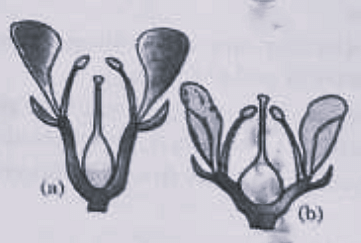Take one flower of the family Solanaceae and write its semi-technical description. Also draw their floral diagram.
Approach Solution - 1
(1) Family Fabaceae/Papilionaceae (pea plant)
Fabaceae/Papilionaceae is a sub-family of the Leguminoseae family
Vegetative features:
Habit: Pinnately compound, alternately arranged with leaf tendrils with the pulvinus present at the leaf base along folacious stipules.
Root: Tap root system with root nodules.
Floral features:
Inflorescence: Racemose, generally axial than terminal
Flower: Zygomorphic and bisexual flowers are found
Calyx: It contains five sepals which are gamosepalous while aestivation is imbricate.
Corolla: It contains five petals (polypetalous) with vexillary aestivation.
Androecium: It consists of ten anthers that are diadelphous with dithecous anthers.
Gynoecium: Monocarpellary superior ovary which is unilocular with marginal placentation.
Fruit: Legume pod with non-endospermic seeds
Floral formula: 
Economic importance: Peas are used as vegetables for making various culinary preparations.

(2) Flowers of Solanum nigrum
Family Solanaceae
Vegetative features:
Habit: Erect, herbaceous plant
Leaves: Simple, exstipulate leaves with reticulate venation
Stem: Erect stem with numerous branches.
Floral features:
Inflorescence: Solitary and axillary Flowers: Actinomorphic, bisexual flowers
Calyx: Calyx is composed of five sepals that are united and persistent. Aestivation is valvate.
Corolla: Corolla consists of five united petals with valvate aestivation.
Androecium: It consists of five epipetalous stamens.
Gynoecium: It consists of bicarpellary syncarpous superior ovary with axile placentation.
Fruits: Berry
Seeds: Numerous, endospermous
Floral formula:
Economic importance: Used for medicinal purposes.
Approach Solution -2
Habit & Vegetative characters
- Habit: Herb, erect; annual/perennial.
- Root: Tap root, branched.
- Stem: Aerial, herbaceous, green, branched, solid, cylindrical.
- Leaves: Alternate, simple, exstipulate, petiolate; lamina ovate, entire to shallowly toothed; venation reticulate.
Inflorescence
- Axillary, cymose (often extra-axillary dichasial/solitary clusters).
Flower (diagnostic)
- Bracts: Usually present (bracteate).
- Symmetry: Actinomorphic (\(\oplus\)).
- Sex: Bisexual (⚥).
- Inserts: Hypogynous.
- Merosity: Pentamerous (5 in each perianth/androecium whorl).
Calyx
- \(K(5)\) — sepals 5, gamosepalous, small, persistent; aestivation valvate.
Corolla
- \(C(5)\) — petals 5, gamopetalous, rotate (wheel-shaped) and white; lobes 5; aestivation commonly valvate (plicate in some genera).
Androecium
- \(A_5\) — stamens 5, epipetalous, alternating with corolla lobes; filaments short.
- Anthers dithecous, basifixed, introrse, often connivent (forming a cone), dehiscing by apical pores (poricidal).
Gynoecium
- \(G\underline{(2)}\) — bicarpellary, syncarpous; ovary superior, usually bilocular (may appear 2–4 locular); placentation axile; style 1; stigma bilobed.
Fruit & Seed
- Fruit a berry with many seeds; seeds albuminous, embryo curved.
Floral formula: \[ \mathrm{Br}\; \oplus\; \text{⚥}\; K(5)\; C(5)\; A_5\; G\underline{(2)} \quad \text{(ovary superior, axile placentation)} \]
Floral diagram (schematic)

Top Questions on The Flower
- Identify the set of correct statement:
A. The flowers of Vallisneria are colourful and produce nectar.
B. The flowers of waterlily are not pollinated by water.
C. In most of water-pollinated species, the pollen grains are protected from wetting.
D. Pollen grains of some hydrophytes are long and ribbon like.
E. In some hydrophytes, the pollen grains are carried passively inside water.
Choose the correct answer from the options given below- NEET (UG) - 2024
- Biology
- The Flower
- Match List I with List II
List I (Types of Stamens) List II (Example) A Monoadelphous I Citrus B Diadelphous II Pea C Polyadelphous III Lily D Epiphyllous IV China-rose
Choose the correct answer from the options given below:- NEET (UG) - 2024
- Biology
- The Flower
- Which of the following is an example of actinomorphic flower?
- NEET (UG) - 2024
- Biology
- The Flower
- Identify the type of flowers based on the position of calyx, corolla and androecium with respect to the ovary from the given figures (a) and (b).

- NEET (UG) - 2024
- Biology
- The Flower
- Identify the correct description about the given figure.

- NEET (UG) - 2024
- Biology
- The Flower
Questions Asked in CBSE Class XI exam
- \(\text{tan x}=-\frac{4}{3},\text{x\, in\, quadrant \,II.}\)
- CBSE Class XI
- Trigonometric Functions of Sum and Difference of Two Angles
- If the function f(x) satisfies \(\lim_{x\rightarrow 1}\) \(\frac{f(x)-2}{x^2-1}\) =\(\pi\), evaluate \(\lim_{x\rightarrow 1}\) f(x).
- \(∆U^Θ\) of combustion of methane is – \(X\ kJ \ mol^{–1}\). The value of \(∆H^Θ\) is
- CBSE Class XI
- Thermodynamics terms
- Write the resonance structures for SO3 , NO2 and NO3-
- CBSE Class XI
- Kossel-Lewis Approach to Chemical Bonding
- Three reasons why the author’s grandmother was disturbed when he started going to the city school.
- CBSE Class XI
- The Portrait of a lady